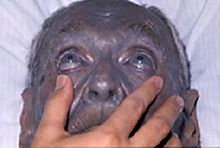
Back Argirië Afrikaans تفضض Arabic Arqiroz Azerbaijani Argíria Catalan Argyrie Czech Argyrie German Argirio Esperanto Argiria Spanish Argüüria Estonian آرگیریا Persian
| Argyria | |
|---|---|
| Other names | Argyrosis |
 | |
| Generalized argyria in a 92-year-old male. | |
| Specialty | Dermatology |
Argyria or argyrosis is a condition caused by excessive exposure to chemical compounds of the element silver, or to silver dust.[1] The most dramatic symptom of argyria is that the skin turns blue or blue-gray. It may take the form of generalized argyria or local argyria. Generalized argyria affects large areas over much of the visible surface of the body. Local argyria shows in limited regions of the body, such as patches of skin, parts of the mucous membrane or the conjunctiva.
The terms argyria and argyrosis have long been used interchangeably,[2] with argyria being used more frequently. Argyrosis has been used particularly in referring to argyria of the conjunctiva, but the usage has never been consistent and cannot be relied on except where it has been explicitly specified.[3] The term is from the Ancient Greek: ἄργυρος (argyros, 'silver').
- ^ James, William D.; Berger, Timothy G.; Elston, Dirk M.; Odom, Richard B. (2006). Andrews' diseases of the skin: clinical dermatology. Saunders Elsevier. p. 858. ISBN 0-7216-2921-0. OCLC 62736861.
- ^ Guttmann, Paul. tr. by A. Napier. A handbook of physical diagnosis comprising the throat, thorax and abdomen. 1879. May be downloaded from https://archive.org/details/ahandbookphysic02guttgoog
- ^ Fox, Lawrance Webster. A practical treatise on ophthalmology. Pub. D. Appleton and company NY. 1920. May be downloaded from https://archive.org/details/apracticaltreat00foxgoog